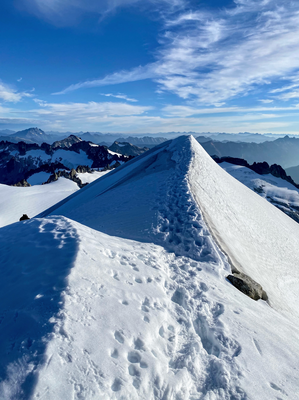
Trip Report
Intermediate Alpine Climb - Eldorado Peak/Northeast Face
Checked out the NE Face in good weather but found the route in snowy rather than icy conditions.
- Sat, Oct 3, 2020 — Sun, Oct 4, 2020
- Intermediate Alpine Climb - Eldorado Peak/Northeast Face
- Eldorado Peak/Northeast Face
- Climbing
- Successful
-

- Road suitable for all vehicles
-
The route is in surprisingly good shape for late season, and there is a good log crossing for the river (which we discovered on our way down rather than on the way up). The approach is snow-free to the glacier with water in the usual places (waterfall, slabs), and the recent (~1.5w ago) snowfall gave the glaciers a refresh to the point there were few visible crevasses on the route up to high camp. High camp bivies had some snow in them (and a pond in one). Above high camp, the East Ridge route is in great shape and on snow the entire way. The NE Face route presented no navigational challenges but was also a snow climb rather than an ice climb.
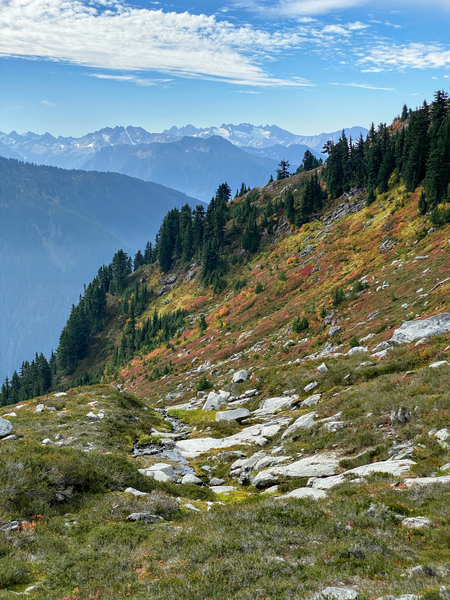
TL;DR
The NE Face as an ice route is a fickle objective. We went after it a week and a half after a significant snowfall and found the route to be mostly snow, and we ascended comfortably as a group of three, placing two screws and two pickets in a running belay.
Gear / Route Options
We carried three pickets, 12 screws plus quickdraws, and two ropes (one of which we elected to leave at camp given the snowy conditions on the approach). In retrospect, six pickets and an alpine rack would have made it possible to cross the bergschrund and ascend the rock band on a snowy ramp to access the 60-degree exposed ice slope above it. This is a different route than in Nelson/Potterfield, and we couldn't safely access it with the gear we had on-hand.
Here is a picture of the rock band and ice above from September 14, 2019, as seen from the East Ridge route. The usual NE Face route traverses across below this and then cuts back left.
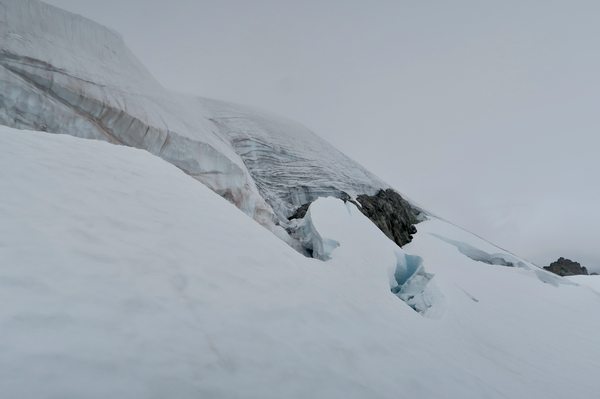
The icy slopes to the NW of the knife edge (climber's right in the image below) would also have made a decent pitch of (alpine) ice to climb up to the knife edge, and they could be accessed by first gaining the start of the knife edge around 8700' and then dropping down to the NW. As above, a few additional pickets would be desirable, and one would risk impeding traffic on the knife edge itself for the belay.
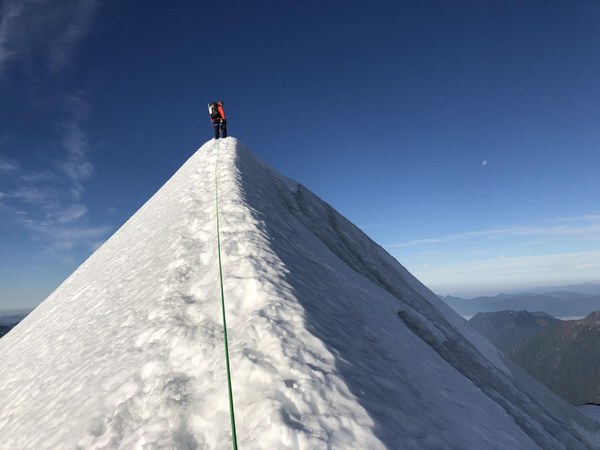
Trip Narrative
Our group started the hike in with overnight packs at a leisurely 9AM on Saturday and made slow but steady progress through hazy and warm conditions up to high camp. A couple of smoky, sedentary weeks and the extra weight of full-length climbing ropes, rack, and second tools makes a difference over a 5700' approach. We were able to get onto the glacier relatively low on climber's right and took the lower path that passes close to the Eggplant. The Eldorado glacier was in surprisingly good condition after a fresh coating of snow from 1.5 weeks prior with any visible crevasses passing the Eggplant or on a straight shot to high camp filled/covered.
Two of us set up bivy sacks in the Eggplant View Suite (6' apart head/foot and foot/head), and the other climber built a snow shelter (as part of equivalency for the field portion of Winter Mountaineering). There are mice at the campsite (one of them perched briefly on my head in the middle of the night), but no larger animals were (apparently) afoot. We pumped/filtered water from a pond in a flooded bivy site elsewhere at the camp.
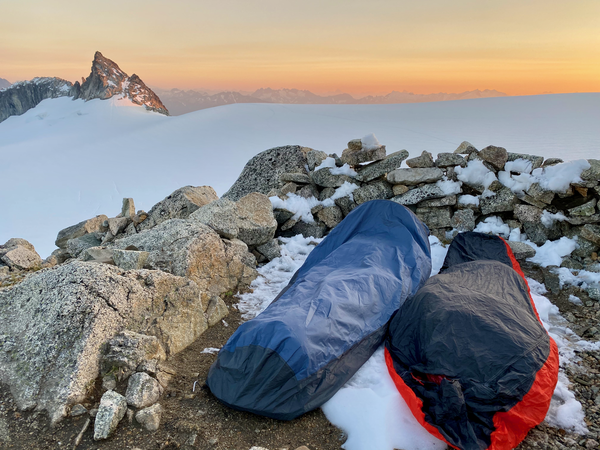
The air was still a bit hazy, but the views were solid.
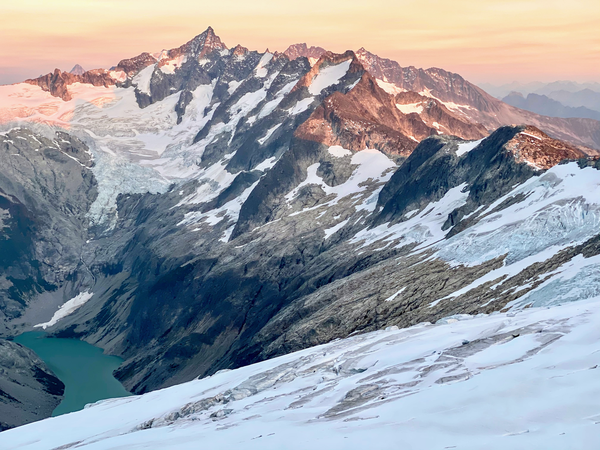
On Sunday, we woke just before sunrise, ate breakfast, roped up, and left camp on hard snow at 7AM. To survey the route, we turned off the East Ridge route at around 7500' but ended up converging with a bootpack that traversed the slope under the rock band at about 8200' and paralleling a large crevasse. At the end of the crevasse and roughly due NE of the summit, we turned and headed uphill, placing two pickets and two screws in a running belay to get to the base of the knife edge. We used mostly American and French technique and a limited amount of front-pointing, and none of us felt a need to get out a second tool. Even in icier conditions, medium-aggressive tools like a Quark would be overkill on this route.
On the knife edge itself, we placed one screw in hard, exposed ice just below the edge and two pickets (both of which took a serious pounding to get in). We mostly plunge-stepped our way back to camp in warming snow, packed up, and headed for the cars; we were at the cars at just before 2:00PM.
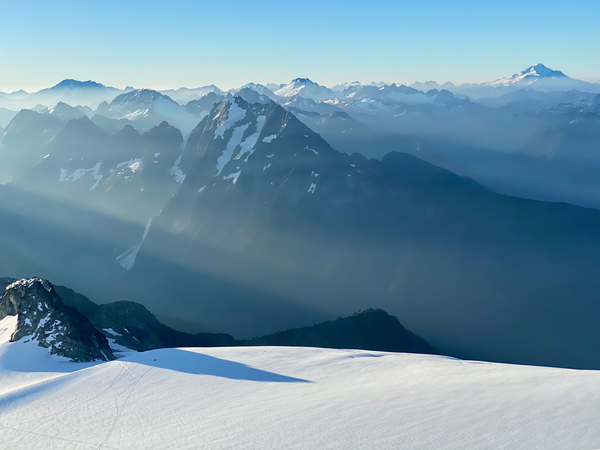
Note on Permits
This year, permitting was a little different due to COVID. We obtained a backcountry permit on Friday at 9AM, and we heard from another team that they were still able to obtain a permit first thing on Saturday morning (at 7AM). Based on the number of teams camping either at high camp (two) or lower on the glacier or slabs (two), all (six) permits may or may not have been used for the weekend. Note that other areas (Sahale Arm) were already sold out for the weekend by 9AM on Friday with people likely headed out to enjoy Fall colors and good weather.
 Paul Brown
Paul Brown